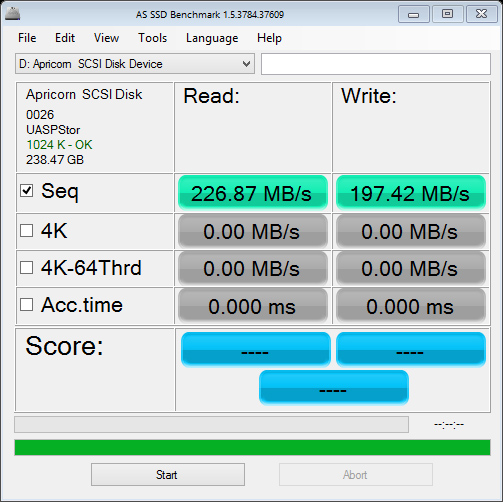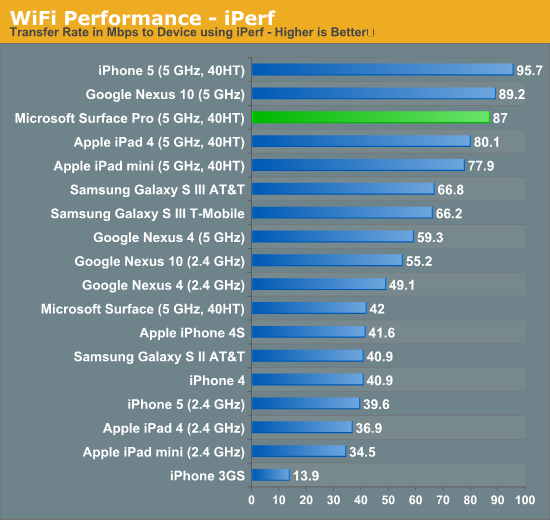Microsoft Surface Pro Review
by Anand Lal Shimpi on February 5, 2013 9:00 PM ESTFans and Thermals
While Surface RT was passively cooled, Surface Pro features two integrated fans to cool the 17W Core i5-3317U. For most light use cases, those two fans will remain spun down and you can’t hear them. Do any sort of serious multitasking or start using Surface Pro as a real PC instead of a tablet and you’ll quickly hear them spin up. Fan noise is audible but not annoying - it’s very similar to the sound you’d hear out of any ultraportable with a couple of tiny fans spinning up.
In landscape mode with the Type Cover attached, Surface Pro draws in cool air from the sides and exhausts it out of the top of the device. Rotate the device into portrait mode and the fans will switch directions, drawing in cool air from the long edge and exhausting it out of the short edges. The fan direction switch is triggered in tandem with display rotation, so as soon as you see your display rotate you’ll hear the fans change direction.
The two fans do a good job keeping the CPU cool (I saw typical CPU core temperatures between 50C - 60C), but Surface Pro does get warm. I measured a max surface temperature of 41.8C while running 3DMark 11. That’s towards the top of the unit, around where the Core i5 CPU is located. On the edges I measured a max surface temperature of 36.5C. There’s no getting around the fact that Surface Pro gets warm, noticeably more so than the 4th generation iPad. It never gets uncomfortably hot however.

Despite being a tablet, the Core i5-3317U had no issues hitting its max turbo frequency of 2.6GHz. I even saw 2.75GHz for a very short period of time (remember, Intel’s Turbo Boost can exceed max TDP until the silicon gets up to temperature).
Storage and USB 3.0
Surface Pro ships with a micro SDXC slot along the edge of the device. Courtesy of Intel’s HM77 chipset, you also get a full blown 6Gbps SSD and a single USB 3.0 port - both significant upgrades over Surface RT. In my 128GB review sample, Surface Pro features a Micron C400 SSD. Microsoft is sourcing from multiple SSD vendors and claims to be shipping with optimized firmware, but I don’t know what other vendors are in the mix. Update: It looks like the C400 SSD is an mSATA drive, likely similar to the one we reviewed here a while back.

To put this in perspective, the C400 is in the same class of storage device that’s used in Apple’s MacBook Air. Although some ARM based SoCs feature SATA interfaces, pretty much all of them are paired with eMMC based NAND storage solutions that are horribly slow. The fastest sequential transfer rates I’ve managed on the 4th generation iPad are typically on the 20 - 30MB/s range, whereas the C400 in the Surface Pro is good for over 400MB/s in reads and just under 200MB/s in writes.

There’s been a lot of debate over the amount of free space available on Windows RT/8 tablets fresh out of the box. My 128GB review sample was partitioned down to 110GB with roughly 8GB used for the recovery partition. Of that 110GB, 89.5GB was free space that remained. I don’t really view this as false advertising by Microsoft (both Macs and PCs have been sold like this for decades), but you do need to know what you’re getting into here. Given the already high price of these systems and the relatively small price differential between a 64GB Surface Pro and a 128GB model, I’d recommend going for the latter. Microsoft claims something like 29GB of free space remains on the 64GB model - enough for some apps and data, but keep in mind like all solid state storage you don’t want to completely fill up your drive either (this is also true for ARM based tablets like the iPad).
USB 3.0 is equally as impressive on Surface Pro. Using a simple USB 3.0 to SATA adapter I could easily read and write at around 200MB/s. Compare this to the ~20MB/s you get on most ARM based tablets and it’s obvious that this Surface deserves its Pro moniker.

Ultimately Surface Pro’s storage subsystem is a big part of what separates it from the current crop of ARM based tablets. While it’s possible to run productivity workloads on many tablets these days, there’s truly very little that separates what you can do on Surface Pro with what what you can do on a conventional PC.
WiFi Performance
Similar to Surface RT, Surface Pro uses a 2x2 802.11n WiFi controller from Marvell. I believe this is likely the same Marvell Avastar 88W8797 WiFi solution, but connected over USB instead of SDIO.
WiFi performance is appreciably better than on Surface RT, connected to a 5GHz 802.11n network I was able to pull a maximum of 87Mbps compared to 42Mbps on Surface RT. This is competitive with what I’ve seen on other high-end tablets based on ARM architectures, although lower than what I’ve gotten out of a MacBook Air.

WiFi range is subjectively really good on Surface Pro and a lot better than most ARM based tablets I’ve played with. I ran an iperf test on an iPad 4 and Surface Pro around 100 feet away from an AP through several walls and saw roughly an order of magnitude better performance out of the Surface Pro (8 - 10Mbps vs. 0.95 Mbps).
While peak WiFi performance out of Surface Pro is similar to a high-end tablet, worst case performance is more like a good notebook. Overall I’m pleased with the wireless stack on Surface Pro.










228 Comments
View All Comments
BSMonitor - Wednesday, February 6, 2013 - link
Because most people who are hardware reviewers see red flags only.. $899.. And the rest of the review is based on that..Surface Pro is the MOST productive tablet available. BY FAR. Why? because it's a PC in tablet form.
BSMonitor - Wednesday, February 6, 2013 - link
Has there been any talk/musings about a hybrid APU featuring both an Atom and the traditional Ivy Bridge/Haswell cores on a single die??I believe your last podcast mentioned the Octus or Octal or whatever in the ARM space. Seems like for a powerful, but mobile Surface Pro, this is a no brainer. If I want to switch to battery life mode and get 9-10 hours, Win 8 can be made to only schedule on the Atoms and power gate off Haswell.
Or does Intel really believe they can get Haswell and beyond into the power space of Atom/ARM??
dcianf - Wednesday, February 6, 2013 - link
The review said that in power saver mode it runs at 800MHz. Can you force the low clock rate? If so, how would performance and battery life compare to ARM?Netscorer - Wednesday, February 6, 2013 - link
That's actually a good point. Anand delivered performance charts based on fully powered core i5 and battery results based on clocked chip at 800MHz. Many people don't realize that you don't get both (and review does not help to highlight that difference) - either you are using it in light mode for stated hours or you run some complex program and have to be always connected because CPU would seep power like a thirsty kid on hot afternoon.marco89nish - Wednesday, February 6, 2013 - link
I also want to see how much battery life you can get on power saving mode. Peformance would also be nice, but it's predictable I guess, So, please, battery life on power saving mode. I registered to post this comment.smartypnt4 - Wednesday, February 6, 2013 - link
Anand, are you guys planning on reviewing the ASUS TAICHI21? The base model is $1300, which is only $170 more than the Surface Pro with a Type Cover, and it solves the lap usage problem while maintaining mostly the same battery life. I'll grant that it's a bit heavier, but I've got one and I absolutely love it. Those screens are just stunning.Beenthere - Wednesday, February 6, 2013 - link
That was just another scam by InHell.twotwotwo - Wednesday, February 6, 2013 - link
The Pro seems, in this and other reviews, to always get the unfavorable comparison on each dimension--it's not a thinner, lighter thin-and-light, it's either a heavy, bulky iPad or a bit slow for the most advanced games, depending on context.Microsoft seems to be betting that some folks can live with tradeoffs to get a super portable fully-functional computer. I really hope they're right; I'd like my next computer to be like this, and I'll have more options if this (or something like the Acer W700--I'd happily lose the pen and apparently unreliable covers) does well.
scsi stud - Wednesday, February 6, 2013 - link
Hi Anand,Would yod mind posting up a screenshot of the Surface Pro's desktop in full 1080p resolution? I'm curious to see how an application like Visual Studio 2012 would look like.
My hopes for this device were to be my go-to device for sitting on my couch writing code after I put my kids to sleep...
Thanks in advance.
spencer.p - Wednesday, February 6, 2013 - link
I am curious, Anand, if you can test to see if the Surface Pro works with the widi standard that Intel is pushing out and if it's also possible to get the Surface Pro to a 30" dual-link DVI monitor via one of those mini-displayport to dual-link DVI adapters. I am really curious if the Surface Pro will be able to meet my use case.